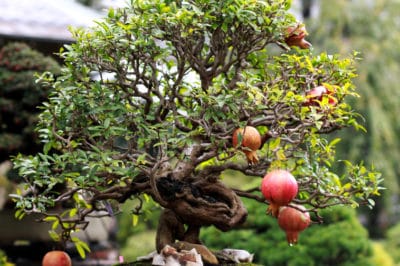About Bonsai
Bonsai is a combination of art and gardening practiced by the Japanese and derived from the more ancient Chinese tradition of penzai. The goal is to create an esthetically pleasing “landscape” using trees or shrubs and ground covers. The plant is not a natural or genetic dwarf but is pruned and trained into its final form. Pines, azaleas, junipers and other trees are often used in bonsai.
Choosing Pomegranates for Bonsai
Although the natural dwarf pomegranate ‘Nana’ only grows three feet high, other pomegranates can be made into bonsai. Try these varieties:
- Angel Red
- Wonderful
- Red Silk
- Sharp Velvet
- Pink Satin
- Eversweet
- Kashmir.
Watering Pomegranate Bonsai
The small pot common to bonsai specimens means that watering can be tricky. Frequency is critical – many bonsai must be watered once or even twice a day. However, drainage is equally important to prevent the roots from developing fungal diseases and rot. You may also need to mist the plant daily. Keep the soil damp but not wet.
Fertilizer for Pomegranate Bonsai
Pomegranates grown in the garden – which you can do in USDA Zones 7 to 10 – don’t need much in the way of fertilizer. Nutrients in a pomegranate bonsai quickly become depleted because of the frequent watering and small pot capacity. Use a liquid fertilizer specifically developed for bonsai. Start feeding in spring when growth resumes and feed every two or three weeks.
Pruning and Wiring a Pomegranate Bonsai
Pruning and wiring shape the bonsai and keep it small. Pinch back the first or third set of leaves to make foliage bushier. Allow a branch to grow a little longer than you want it to be and then cut back just above a growth node. Wrap wire around the trunk and then out a branch. Watch carefully to prevent damage to the bark and remove the wire if it occurs.
Repotting Pomegranate Bonsai
No matter how small your pomegranate bonsai is, it will eventually outgrow its pot or need fresh soil. In order to keep a bonsai the same size, you must prune the roots when you repot. In most cases, that means removing about one-third of the roots at each repotting session – keep about half of the very fine roots. You should also remove an equal amount of leaves at this time.
